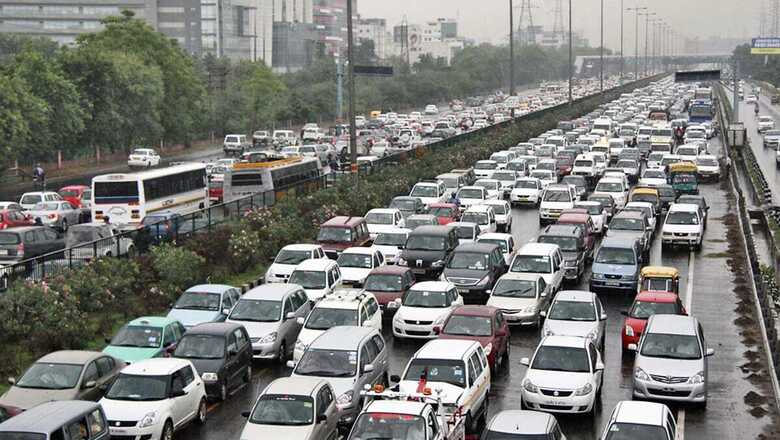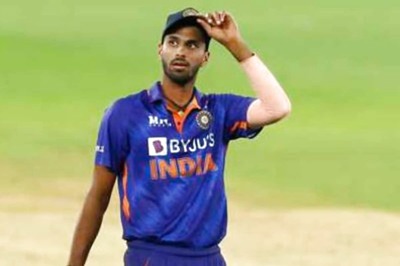
views
As air pollution during the winter threatens to cripple Delhi’s fight against Covid-19, Chief Minister Arvind Kejriwal has announced a unique campaign called ‘Red Light on, Gaadi off’ to contain the rising levels of pollution.
The campaign will exhort people to turn off their ignition as they wait at traffic signals for the green light. The CM said that Delhi has about one crore registered vehicles and even if 10 lakh turn off the ignition at traffic signals, particulate matter (PM) 10 levels would go down by 1.5 tones and PM 2.5 levels by 0.4 tonnes in one year.
Seeking to make the campaign attractive, Kejriwal highlighted that the practice would result in financial gains as car-owners would save up to Rs 7,000 every month as a result of saving 200 ml of fuel every time the ignition is switched off.
This campaign is a take off from the popular campaign to fight dengue in the national capital, which Kejriwal has led from the forefront. Called ‘Dus Hafte, Dus Baje, Dus Minute’, the campaign is well into its second innings.
Jasmine Shah, a key member of the CM’s core team and vice chairperson of the think tank Dialogue and Development Commission said, “We knew that this year the problem of pollution in addition to the coronavirus pandemic could deal a deadly blow. The CM, ministers and experts have been brainstorming on the winter action plan to do whatever is possible in Delhi.”
Shah said that the air pollution is at its peak in mid-October and November every year due to stubble burning in neighbouring states, and that the Delhi government is helpless in the situation. “The challenge before us was to control the local sources of pollution. We went source-by-source,” he said, explaining how the campaign came about.
Illustrating the strategy of the Kejriwal government, Shah explained the experimental use of the Pusa bio decomposer – developed by the Indian Agriculture Research Institute – in farms on the periphery of Delhi as a means of ‘showcasing a solution’.
“If we can stop the pollution happening at traffic signals, we will be successful in not just reducing pollution but in bringing about a change in the larger consciousness. It is the brainchild of the CM. Even in the case of the odd-even vehicle policy, that is the idea. You can make a difference,” Shah said.
As CM, Kejriwal has tried to involve citizens in tackling the biggest issues facing them. Senior journalist Neerja Chowdhury said, “From the decision making process — even though he did do it right during Covid times — to taking the opinion of people on reserving beds in government hospitals for Delhites, his programmes are now geared towards reaching out to the maximum number of people and involving them in action. This was true of ‘Odd-Even’, and ‘Dus Hafte, Dus Baje, Dus Minute’.”
Chowdhury added, “Bringing about change in schools and setting up mobile clinics are programmes for people. Now he is making people active participants. Use of the Pusa bio decomposer to get public involvement in taking up issues that are most current in people’s minds and affecting them the most is innovative.”
Aware that critics and opponents will term it the new scheme as ‘theatrics’, Jasmine Shah is quick to underline that there is a scientific rationale behind every campaign. “In 2015, we saw 15,000-plus cases of dengue and 60 deaths. The year we did the campaign, we saw around 1,800 cases and no deaths. It became a mass movement. Even though it is the MCDs’ job (to ensure that mosquitos don’t breed), it is fascinating how a simple call to action backed by science , not just theatrics can mobilise people.”
In the past few months, the Delhi CM has also spent focused attention on building the organisation of the Aam Aadmi Party across various states such as Punjab, Uttarakhand, Uttar Pradesh and Karnataka. The AAP is serious about expanding its footprint beyond the national capital and the ‘Delhi model’ or the ‘Kejriwal model’ is the calling card of his colleagues in the party attempting a breakthrough in their respective states.
Chowdhury believes that campaigns such as these will embellish Kejriwal’s image as a chief minister who “applies himself to issues of governance and not just of politics and winning elections though politics is at the center of it”.
“When he does a door-to-door campaign in UP or Uttarakhand, he is zeroing in on issues that are most important to them at that moment, making it his entry point, I get the sense that he plans to expand but slowly and cautiously and not make the mistakes he made in the past,” she said.
The Delhi government had worked with researches from Havard University and Chicago to study the impact of the emergency measure of odd-even. Although the ‘Red Light on, Gaadi off’ campaign is based on similar ideas, the first priority is to involve maximum number of people.
The government is yet to release a blueprint of the campaign. Next time, when you are waiting at a traffic signal, don’t be surprised if a civil defence volunteer walks up to you and requests you to switch off the ignition.
Read all the Latest News and Breaking News here

















Comments
0 comment